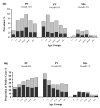Malaria morbidity in Papua Indonesia, an area with multidrug resistant Plasmodium vivax and Plasmodium falciparum
- PMID: 18673572
- PMCID: PMC2518158
- DOI: 10.1186/1475-2875-7-148
Malaria morbidity in Papua Indonesia, an area with multidrug resistant Plasmodium vivax and Plasmodium falciparum
Abstract
Background: Multidrug resistance has emerged to both Plasmodium vivax and Plasmodium falciparum and yet the comparative epidemiology of these infections is poorly defined.
Methods: All laboratory-confirmed episodes of malaria in Timika, Papua, Indonesia, presenting to community primary care clinics and an inpatient facility were reviewed over a two-year period. In addition information was gathered from a house-to-house survey to quantify the prevalence of malaria and treatment-seeking behaviour of people with fever.
Results: Between January 2004 and December 2005, 99,158 laboratory-confirmed episodes of malaria were reported, of which 58% (57,938) were attributable to P. falciparum and 37% (36,471) to P. vivax. Malaria was most likely to be attributable to pure P. vivax in children under one year of age (55% 2,684/4,889). In the household survey, the prevalence of asexual parasitaemia was 7.5% (290/3,890) for P. falciparum and 6.4% (248/3,890) for P. vivax. The prevalence of P. falciparum infection peaked in young adults aged 15-25 years (9.8% 69/707), compared to P. vivax infection which peaked in children aged 1 to 4 years (9.5% 61/642). Overall 35% (1,813/5,255) of people questioned reported a febrile episode in the preceding month. Of the 60% of people who were estimated to have had malaria, only 39% would have been detected by the surveillance network. The overall incidence of malaria was therefore estimated as 876 per 1,000 per year (Range: 711-906).
Conclusion: In this region of multidrug-resistant P. vivax and P. falciparum, both species are associated with substantial morbidity, but with significant differences in the age-related risk of infection.
Figures




References
-
- NIHRD . National Health Survey. Jakarta: National Institute of Health research and Development; 2001.
-
- Laihad F. 7th Jakarta Antimicrobial Update 2006; Facing the challenge of antimicrobial resistance. Jakarta: Centre for Disease Control; 2006. The policy and situation of malaria treatment in Indonesia.
-
- Baird JK, Basri H, Purnomo , Bangs MJ, Subianto B, Patchen LC, Hoffman SL. Resistance to chloroquine by Plasmodium vivax in Irian Jaya, Indonesia. Am J Trop Med Hyg. 1991;44:547–552. - PubMed
Publication types
MeSH terms
Grants and funding
LinkOut - more resources
Full Text Sources
Medical

